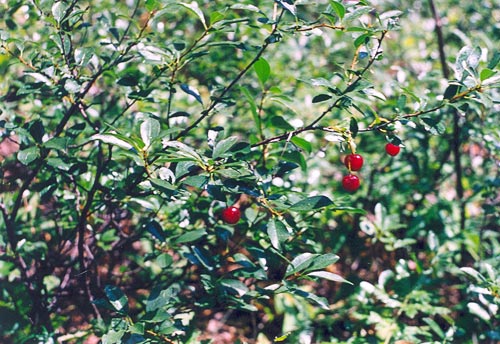Relatives
Cerasus fruticosa Pall. - Ground cherry, steppe cherry.
Taxonomic position.
Family Rosaceae Juss. genus Cerasus Hill.Synonyms.
Prunus fruticosa Pall.Morphology and biology.
Usually a low shrub, 0.5-1 m high, seldom reaching 2 m, developing root suckers. Old branches are dark-gray, upright or slightly drooping. Young offshoots are dark-brown, sometimes greenish, naked or weakly pubescent, covered with lenticels. Leaves are up to 5 cm long and 2.5 cm wide, elongated elliptic or obovate, acuminate or obtuse at the tip, obtusely dentate along the edge, with denticles terminating in a cartilaginous cusp, naked from both sides, dark-green from above and lighter colored from below. Petioles are short, 3-15 mm, without glandules. Stipules are narrow, linear, dentate. Flowers are white, 12-18 mm in diameter, grouped in sessile or short-stalked umbellate inflorescences, set by (2) 3-4 on naked pedicels 15-30 mm long, lengthening under fruits up to 40 mm. Hypanthium is bell-shaped. Fruits are 8-10 (15) mm in diameter, varying from globular to oblong-ovoid, usually crowned by a short cusp, red and dark-red, with juicy sour-sweet pulp. Kernels are smooth, almost globular or ovoid. Entomophilous. Ornitochore. Propagated by seeds, root and softwood cuttings. Seeds require stratification for 4-5 months at 3-5 degrees Centigrade. Blossoms in April/May; bears fruit in July/August. 2n=32.Distribution.
Eastern Europe (central and southern parts), Ante-Caucasus, Western Europe (central and southern parts), south-western areas of Western Siberia, Northern Kazakhstan.Ecology.
Mesoxerophyte, drought-resistant. Photophilous. Gas-resistant. Grows under the canopy of thin pine and birch forests, on clearings, glades and edges. Most often participates in forming shrub thickets within the forest-steppe and steppe zones, in most cases tending to gully slopes and foothills. Everywhere appears in clumps or forms extensive thickets.Utilization and economic value.
Food (fruit), ornamental, melliferous. Fruits are consumed fresh or used to make confectionary products. Very promising as a fruit-bearing plant. In the south of Western Siberia it is widely used as a breeding source of valuable cold- and drought-resistant cherry cultivars, suitable for large-scale cultivation. It is considered one of the hypothetical ancestors of cultivated cherry species, generated by hybridization of C. fruticosa with C. avium.References:
Brezhnev, D.D., Korovina, O.N. 1981. Wild relatives of cultivated plants in the flora of the USSR. Leningrad: Kolos, pp.182-183. (in Russian).Koropachinskiy, I.Yu., Vstovskaya, T.N. 2002. Woody plants of the Asian part of Russia. Novosibirsk: Publishing House of SB RAS, Branch "Geo", pp.300-301. (in Russian).
Poyarkova, A.I. 1941. Cherry - Cerasus Hill. (Flora of the USSR.) Moscow/Leningrad: Publishing House of the USSR Academy of Sciences, vol. 10, pp.558-559. (in Russian).
Sokolov, S.I., Svjaseva, O.A., Kubli, V.A. 1980. Areas of distribution of trees and shrubs in the USSR. vol.2. Leningrad: Nauka, pp.110-111. (in Russian).


